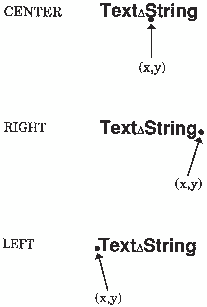TEXALIGN
Specifies the horizontal and vertical alignment
of the text string
| Operating state: |
GKOP, SGOP, WSAC, WSOP |
| Default: |
halign=NORMAL, valign=NORMAL
|
Syntax
return-code-variable=GSET('TEXALIGN', halign, valign);
Required Arguments
- halign
-
character string enclosed
in quotation marks or character variable name. Valid values are as
follows:
-
-
-
NORMAL (the natural alignment based
on the text path); alignment is chosen according to the following
logic:
-
If TEXPATH is 'RIGHT', then NORMAL is 'LEFT'.
-
Otherwise, if TEXPATH is 'LEFT', then NORMAL is 'RIGHT'.
-
Otherwise, the text string is centered.
-
- valign
-
character string enclosed
in quotation marks or character variable name. Valid values are as
follows:
-
BASE (alignment based on the baseline
of the text string)
-
BOTTOM (alignment based on the
bottom of the text string)
-
HALF (alignment based on the vertical
midpoint of the string)
-
NORMAL (natural alignment based
on the text path); alignment is chosen according to the following
logic:
-
If TEXPATH is 'RIGHT' or TEXPATH is 'LEFT', then NORMAL
is 'BASE'.
-
Otherwise, if TEXPATH is 'UP', then NORMAL is 'BOTTOM'.
-
Otherwise, if TEXPATH is 'DOWN', then NORMAL is 'TOP'.
-
TOP (alignment based on the top
of the string).
Return Codes
- This function returns:
-
Details
The GSET('TEXALIGN',
. . . ) function sets a particular type of horizontal and vertical
alignment for text strings.
Halign Values illustrates
halign.

